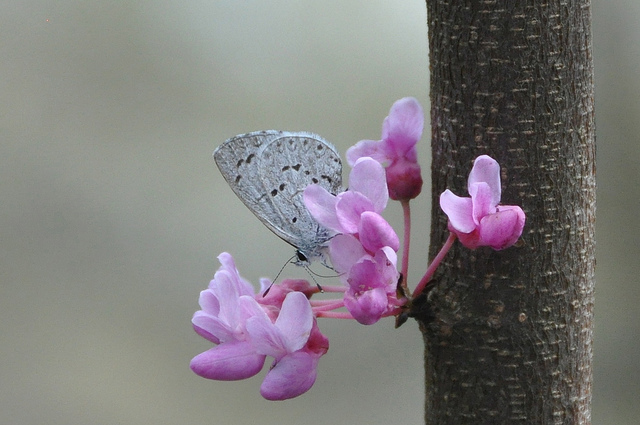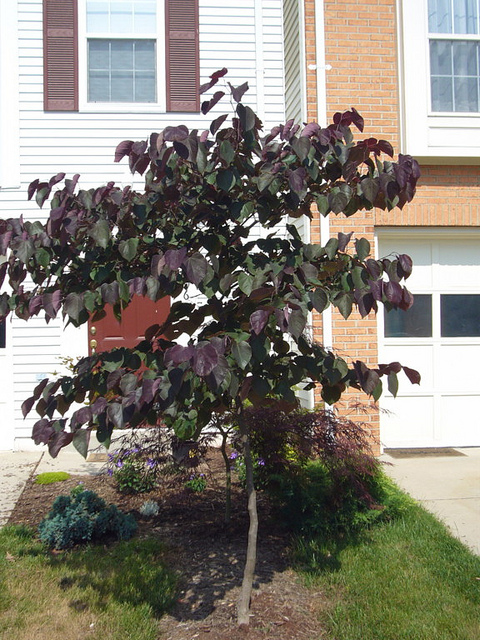Today, we continue our landscape design for birds and the people that love them by adding the rest of our trees. In my last post, we ended by adding three Scarlet oak trees.

Lets start by adding some more shade for the people in this landscape. Our circular patio is pretty exposed right now to the hot summer sun. So lets add a smaller tree to shade it.
This tree will be in the middle of the turf. Therefore it really stands out when the yard is viewed from the house. It also is right up close to the seating area outside. All this means is this tree needs to be ornamental as well as a provider of shade to our patio.
This is a great spot for a tree that not only provides shade and wildlife value but could also serve as a focal point for the yard.
Adding a focal point tree
My choice is the native Eastern Redbud (Cercis canadensis ). This native to the eastern United States provides a splash of color in the spring with its magenta pink flowers on bare branches in early Spring. It also provides an attractive reddish brown bark as it ages.
Redbuds do also provide insects for birds to feed their young. This includes the spring azure butterfly (Celastrina ladon) that lays it’s eggs on redbud foliage.

photo credit: Dave Govoni via photopin cc
Redbud seedpods are also an occasional source of food for about 15 species of songbirds.
A regular Redbud would work fine for this spot, but I am going to really make it a focal point by selecting a purple leaf variety, the Forest Pansy Redbud (Cercis canadensis ‘Forest Pansy’).
This tree is hardy in zones 5-9, so if you in zone 4 forget this one. A regular Redbud grown from cold hardy seed source can make it down to zone 4, so I would use that instead.
But be careful, Redbuds sold at Big Box stores are usually NOT hardy to zone 4. In fact some seem to not even be hardy to zone 5 as they are mostly grown in Tennessee from southern seed stock. If you are in zone 4 be sure to buy from a good local nursery that uses cold hardy seed sources.
If your in a colder zone then 4, you would have to use a completely different tree.

photo credit: outdoorPDK via photopin cc

photo credit: wangspeed via photopin cc
Here is how our plan looks with the Redbud added.

A grove of trees provides summer food for the birds
The next trees we will add to our landscape design for birds, is a group of three Serviceberry. We will use three Autumn Brilliance Serviceberry (Amelanchier × grandiflora ‘Autumn Brilliance’).
This tree is a hybrid cross between two North American serviceberry, the Downy Serviceberry (A. arborea) and the Allegheny serviceberry (A. laevis).
They are small, usually multi-trunked understory trees or tall shrubs which mature to around 20’ tall. White Flowers bloom in April. June edible fruits follow.

photo credit: CR1010 via photopin cc
The Berries are loved by birds. They taste a bit like blueberries and may be used in jams or pies. Even if you decide to try and beat the birds to some of them, you still will have to resist just eating them all before you get to your kitchen.

photo credit: UFORA via photopin cc
Of course, these plants are named Autumn Brilliance for a reason. The dark green summer foliage turns a brilliant orange-red in fall. Our small grove should create a very nice fall effect.

Adding Winter fruit to our landscape design for birds
A birds got to eat even in the winter. Sure, there are usually less birds around due to Fall migration, but several species will stick around in the dead of winter even when I am about ready to hop on a plane out of Chicago to anywhere warm.
Luckily for the birds, some trees and shrubs provide berries that persist into winter.
One of the best of them is the commonly available Sugar tyme™ crabapple (Malus ‘Sutyzam’). Not only does it have red fruit that last well into winter for the birds to eat, it also has sweet smelling white spring flowers and excellent disease resistance.

photo credit: HorsePunchKid via photopin cc
Since we probably will be doing most of our bird watching in winter from indoors, we will put this tree up close to the house. This will help us get a great view of the birds that do come in January and February. The red berries also look great in the winter until they are ready to be eaten by the birds.
Here is how our design looks with the crabapple added.

Adding a native evergreen tree
So far, we have added trees to provide the birds with food and places to build nests. Now lets add a spot for shy birds to hide as well as for shelter in the cold winter months. To do this we will add a evergreen tree, the Canadian Hemlock (Tsuga canadensis).
These may eventually outgrow this design, but it will be a long time and with some pruning their size can be controlled.

By Thesurvived99 (Own work) [CC BY-SA 3.0], via Wikimedia Commons
Besides providing much needed evergreen cover for birds, it is also a larval host for the Columbia silkmoth (Hyalophora columbia) according to Ladybird Johnson Wildflower Center. I personally think it’s a rather pretty looking moth. Even if this picture gives you the ebee jebee’s, most of the caterpillars get eaten by birds before they even become moths!

photo credit: BugMan50 via photopin cc
The evergreen foliage of the Canadian Hemlock is also badly needed for the yard to look good in all seasons. We will add three of these trees to the back bed of our yard and one to the side bed. Here is how our design would look with these added.

We covered a lot of trees today, on our next post we will add shrubs to our landscape design for birds. If you liked this post please share on Facebook, twitter or other! If you have any questions or comments please write them below.
Bill Plummer says
Are you going to do a design plan for birds for the R=Front Yard?
Jim says
Probably not, but I have done a couple two part designs for front yards a while back. Looking back on them there are a few things I would like to change, but here they are:
Front yard design for a yard with Black walnuts Part 1 of 2
Front Yard Design for Winter Interest part 1 of 2